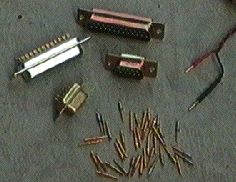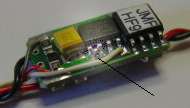Tips (4)
4-blades prop:
![]() Try a second
propeller (identical to the first one!), crosswise mounted. The
current is only 20% higher but the traction increases significantly.
For example, an Indoor which could not take off is now flying without
difficulty. However unnecessary on the XXS "Hi-tech" or the
Drosophile with proposed motors!
Try a second
propeller (identical to the first one!), crosswise mounted. The
current is only 20% higher but the traction increases significantly.
For example, an Indoor which could not take off is now flying without
difficulty. However unnecessary on the XXS "Hi-tech" or the
Drosophile with proposed motors!
Connectors:
![]() It is
possible to get good and cheap connectors for indoor needs by using
just the insertable contacts of multi-contacts electronic connectors
such as DB-25 types (male and female), generally used for serial
ports in PC-computers. AMP, Amphenol, Canon, etc. all make high
quality contacts for their industrial connectors. Normally they are
inserted into housings but you can easily break the housing to get
individual contacts, solder wires to them and then use heatshrink to
build pretty small connector sets. If there's an industrial
electronic store near you they can even sometimes provide you with
individual contacts. In all cases, the unit price is very low (10 to
20 cents each), so don't hesitate and buy the best quality...
It is
possible to get good and cheap connectors for indoor needs by using
just the insertable contacts of multi-contacts electronic connectors
such as DB-25 types (male and female), generally used for serial
ports in PC-computers. AMP, Amphenol, Canon, etc. all make high
quality contacts for their industrial connectors. Normally they are
inserted into housings but you can easily break the housing to get
individual contacts, solder wires to them and then use heatshrink to
build pretty small connector sets. If there's an industrial
electronic store near you they can even sometimes provide you with
individual contacts. In all cases, the unit price is very low (10 to
20 cents each), so don't hesitate and buy the best quality...

Transport box:
|
|

|
HF speed-controllers for coreless motors:
![]() Coreless
motors such as DC5-2.4, 1717, should not be used with ESC without any
precaution. In fact, the internal inductance of these motors is too
low for a good filtering of current peaks generated by the electronic
switching of usual ESC with a switching frequency around 3 kHz. Peaks
of 10 times the nominal current are possible, i.e. 10 A for a mean
current of 1 A! As a result, the efficiency of the motor, the life
duration of the brushes and even the capacity available from the
battery will be reduced significantly.
Coreless
motors such as DC5-2.4, 1717, should not be used with ESC without any
precaution. In fact, the internal inductance of these motors is too
low for a good filtering of current peaks generated by the electronic
switching of usual ESC with a switching frequency around 3 kHz. Peaks
of 10 times the nominal current are possible, i.e. 10 A for a mean
current of 1 A! As a result, the efficiency of the motor, the life
duration of the brushes and even the capacity available from the
battery will be reduced significantly.
![]() In such cases
motor manufacturers recommend to put in series with the motor a coil
to improve the filtering.Unfortunately, these coils must have a quite
high inductance value to be efficient and therefore have a big size
and an high weight which are not compatible with indoor models.
In such cases
motor manufacturers recommend to put in series with the motor a coil
to improve the filtering.Unfortunately, these coils must have a quite
high inductance value to be efficient and therefore have a big size
and an high weight which are not compatible with indoor models.
![]() There is another
smarter solution: use a low inductance coil but increase its
impedance by using an ESC with a high switching frequency. Indeed
impedance is proportional to inductance but also to current
frequency. So, a given coil with a 60 kHz current passing through
will have the same impedance (and therefore the same efficiency) as a
coil with an inductance value 20 times higher but with only a 3 kHz
current.
There is another
smarter solution: use a low inductance coil but increase its
impedance by using an ESC with a high switching frequency. Indeed
impedance is proportional to inductance but also to current
frequency. So, a given coil with a 60 kHz current passing through
will have the same impedance (and therefore the same efficiency) as a
coil with an inductance value 20 times higher but with only a 3 kHz
current.
![]() It is now
possible to find ESC using this principle on the indoor market. I
have been trying for 6 months now a prototype device from JMP-France
with a 60 kHz switching frequency. You will find hereafter a
comparison table between standard and HF ESC performances:
It is now
possible to find ESC using this principle on the indoor market. I
have been trying for 6 months now a prototype device from JMP-France
with a 60 kHz switching frequency. You will find hereafter a
comparison table between standard and HF ESC performances:
|
DC5-2.4 motor |
|
1/7.5 gearbox | |||||
|
Prop speed |
|
|
|
|
|
| |
|
| |||||||
|
Measured voltage |
|
|
|
|
|
| |
|
Measured current |
|
|
|
|
|
| |
|
Electrical power |
|
|
|
|
|
| |
|
| |||||||
|
Measured voltage |
|
|
|
|
|
| |
|
Measured current |
|
|
|
|
|
| |
|
Electrical power |
|
|
|
|
|
| |
|
| |||||||
|
Power gain |
|
|
|
|
|
| |
|
| |||||||
Conclusion:
![]() As you
can see, there is no benefit of using an HF ESC at full throttle
(it's normal, by principle!) but at half or low throttle we can
expect a flight duration 15 to 30% higher. In addition, and this is
the most important, brushes and motor life duration should increase
significantly. I suspect that Li-ion batteries will appreciate as
well as they do not support current peaks!
As you
can see, there is no benefit of using an HF ESC at full throttle
(it's normal, by principle!) but at half or low throttle we can
expect a flight duration 15 to 30% higher. In addition, and this is
the most important, brushes and motor life duration should increase
significantly. I suspect that Li-ion batteries will appreciate as
well as they do not support current peaks!
Note:
![]() Due to current
limitation in the small coil, these HF ESC are only suitable for
small motors such as DC5-2.4 or 1717.
Due to current
limitation in the small coil, these HF ESC are only suitable for
small motors such as DC5-2.4 or 1717.
How to modify the JMP HF9 ESC to work under 3
or 4 cells ?
![]() The normal
operating voltage of the HF9 is from 6 to 10.8 Volts but you can
modify the HF9 by adding a solder link between pins 1 and 2 of the
smallest PIC chip, as shown in the attached picture, and it will work
with 3 or 4 cells only (3.6 to 4.8 V). This modification disables the
undervoltage detection (and therefore also the battery protection
under deep discharge). You could alternatively short the zener diode
(Marked "YT") with a small piece of wire for the same result.
The normal
operating voltage of the HF9 is from 6 to 10.8 Volts but you can
modify the HF9 by adding a solder link between pins 1 and 2 of the
smallest PIC chip, as shown in the attached picture, and it will work
with 3 or 4 cells only (3.6 to 4.8 V). This modification disables the
undervoltage detection (and therefore also the battery protection
under deep discharge). You could alternatively short the zener diode
(Marked "YT") with a small piece of wire for the same result.

Small wires.
![]() Tails of
mouses... computerwise are full of small electric wires with
different colors which the size and the flexibility of are perfectly
suitable for servos or motor connection on most of our Indoor planes.
So, next time your mouse or your friend's one is dead, get its tail
back!
Tails of
mouses... computerwise are full of small electric wires with
different colors which the size and the flexibility of are perfectly
suitable for servos or motor connection on most of our Indoor planes.
So, next time your mouse or your friend's one is dead, get its tail
back!